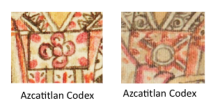tecpan (MH825r)
This is an iconographic example for making comparisons with architectural glyphs. It is a symbol of a pueblo or barrio in Huexotzinco with the devotion of San Gregorio or San Salvador. We are linking this to the term tecpan, municipal palace, which is often the kind of glyph found at the opening of a list of the tribute payers of a given neighborhood or small settlement in this manuscript. If this were a teopantli (temple), and given the presence of Europeans in the vicinity for a generation, it would look more like a church. This building is, indeed, impressive for its evidence of European influence, with its four beautifully carved columns and its stone or adobe foundation of alternating bricks. At the same time, the horizontal design across the top of the building, with its row of four quincunx shapes, harkens to the Nahua designs on the pecheros of huitpiles and some representations of codices. See below.
Stephanie Wood
The horizontal row of decoration across the top of the frontal facade of a tecpan most often involves concentric circles, such as can be seen on the tecpan glyph on folio 5 verso of the Codex Mendoza (below) or the tecpan glyph of the Relación Geográfica of Colhuacan (also below). Other examples come from the Hospital de Jesús. A wonderful living example of a tecpan found in Teposcolula, Oaxaca, is called the Casa de la Cacica. A close-up of the circular designs across that building reveals that the concentric circles alternate with shapes that are more like quincunxes.
Stephanie Wood
sancgregonlion
San Gregorio
Stephanie Wood
1560
Jeff Haskett-Wood
edificio, arquitectura, columnas, quincunces, palacio, gobernación, columnas
Details of pecheros (chest placards) on two huipiles found in the Azcatitlan Codex. These are not yet in the database, so we include them here as a point of reference for common designs found on the rectangular pieces that reinforce the base of the V-neck of huipiles, covering a woman's chest and heart. (SW)
tecpan, royal palace, https://nahuatl.wired-humanities.org/content/tecpan
Matrícula de Huexotzinco, folio 825r, World Digital Library, https://www.loc.gov/resource/gdcwdl.wdl_15282/?sp=725&st=image
This manuscript is hosted by the Library of Congress and the World Digital Library; used here with the Creative Commons, “Attribution-NonCommercial-ShareAlike 3.0 License” (CC-BY-NC-SAq 3.0).







